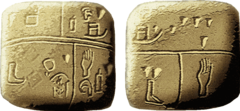Kish tablet

The Kish tablet is a limestone tablet found at Tell al-Uhaymir, Babil Governorate, Iraq – the site of the ancient Sumerian city of Kish. A plaster-cast of the artifact is today in the collection of the Ashmolean Museum.
The Kish tablet is inscribed with proto-cuneiform signs. It has been dated to ca. 3500 BC (middle Uruk period), although some scholars believe it may be from somewhat later – Uruk IV period (ca. 3350–3200 BC).[1] Several thousands of proto-cuneiform documents dating to Uruk IV and III periods (ca. 3350–3000 BC) have been found in Uruk.
The writing is still purely pictographic, and represents a transitional stage between proto-writing and the emergence of the partly syllabic writing of the cuneiform script proper. The "proto-literate period" of Egypt and Mesopotamia is taken to span about 3500 to 2900 BC. The administrative texts of the Jemdet Nasr period (3100–2900 BC), found among other places at Jemdet Nasr and Tell Uqair represent a further stage in the development from proto-cuneiform to cuneiform, but can still not be identified with certainty as being written in Sumerian, although it is likely.[2]
See also
References
- ^ Hayes, John L., 1990 A Manual of Sumerian Grammar and Texts, Undena Publications, p.266
- ^ Woods, Christopher (2010), "The earliest Mesopotamian writing", in Woods, Christopher (ed.), Visible language. Inventions of writing in the ancient Middle East and beyond (PDF), Oriental Institute Museum Publications, vol. 32, Chicago: University of Chicago, pp. 33–50, ISBN 978-1-885923-76-9
Further reading
- A. C. Moorhouse, The Triumph of the Alphabet: A History of Writing
- Langdon, Pictographic Inscriptions from Jemdet Nasr
- Peter N. Stearns, The Encyclopedia of World History (2001), ISBN 978-0-395-65237-4.
